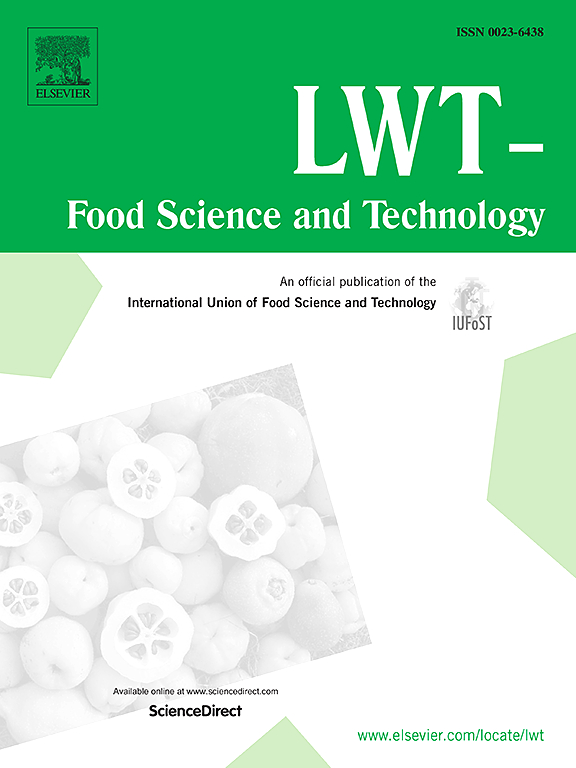ST19鼠伤寒沙门菌与ST34沙门菌I,4,[5],12: I:-的比较:质粒介导的抗生素耐药性与毒力之间的权衡
IF 6
1区 农林科学
Q1 FOOD SCIENCE & TECHNOLOGY
引用次数: 0
摘要
耐多药沙门氏菌(MDR)的不断出现,特别是ST34 S. 1,4,[5],12: I:-,给沙门氏菌病的预防和控制带来了巨大挑战。然而,ST34 S. I,4, b[5],12: I:在全球传播的原因在很大程度上仍然是未知的。采用全基因组测序(WGS)对国内502株沙门氏菌分离株进行毒力分析。然后比较鼠伤寒沙门氏菌与S. I,4,[5],12: I:-在种群结构、毒力/耐药基因分布、致病性等方面的差异。WGS分析显示,毒力基因的分布和流行程度与动物分离沙门氏菌的血清型和STs相关。值得注意的是,ST19-Typhimurium-b、ST34 S. Typhimurium和ST34 S. I、4、[5]、12:I -菌株的毒力基因数量相似,但低于ST19-Typhimurium-a。系统基因组分析显示为ST34型鼠伤寒沙门氏菌/S。I,4,[5],12: I:-菌株聚集在一起,这一组主要来自猪。相比之下,大多数ST19鼠伤寒沙门氏菌菌株聚集在一起,该群体主要来自鸡和鸭。与此同时,大多数ST19鼠伤寒沙门氏菌比ST34 S. I,4,[5],12: I:-/S携带更多的毒力基因,包括pslt2样毒力质粒的标记基因和更少的ARGs。鼠伤寒杆菌,缺乏所有相应的标记基因。基于从动物和人类分离出的15289株鼠伤寒沙门氏菌和S. 1,4, bb0,12: I:-的公开基因组,也发现了类似的情况。小鼠感染模型显示,携带pslt2样毒力质粒的ST19鼠伤寒沙门氏菌菌株的致病性高于鼠伤寒沙门氏菌和S. I,4,[5],12: I:-。高致病性与pslt2样毒力质粒标记基因的存在密切相关。通过比较ST19鼠伤寒沙门氏菌和ST34沙门氏菌I,4,[5],12: I:-基于大型WGS分析,我们的研究结果揭示了质粒介导的抗生素耐药性和毒力之间的权衡。这些发现有助于了解耐多药沙门氏菌的遗传进化,并可能有助于遏制耐多药沙门氏菌的广泛传播和细菌耐药性。本文章由计算机程序翻译,如有差异,请以英文原文为准。
Comparison of ST19 Salmonella Typhimurium and ST34 Salmonella I,4,[5],12:i:-: a trade-off between plasmid-mediated antibiotic resistance and virulence
The increasing emergence of multidrug-resistant (MDR) Salmonella, especially ST34 S. I,4,[5],12:i:-, poses a great challenge to the prevention and control of salmonellosis. However, the reason for the global spread of ST34 S. I,4,[5],12:i: is still largely unknown. Whole-genome sequencing (WGS) on 502 Salmonella isolates collected from animals in China to investigate the virulence profiles. And then, compared the difference of population structure, virulence/antibiotic resistance gene distribution, and pathogenicity between S. Typhimurium and S. I,4,[5],12:i:-. WGS analysis revealed that the distribution and prevalence of virulence genes was correlated with the serovars and STs of Salmonella isolated from animals. Of note, the number of virulence genes among ST19-Typhimurium-b, ST34 S. Typhimurium and ST34 S. I,4,[5],12:i:- strains were similar but lower than for ST19-Typhimurium-a. Phylogenomic analysis indicated ST34 S. Typhimurium/S. I,4,[5],12:i:- strains clustered together and this group were primarily from in pigs. In comparison, most ST19 S. Typhimurium strains clustered together and this group mainly originate from chickens and ducks. Meanwhile, most ST19 S. Typhimurium strains carried a greater number of virulence genes including the marker genes of the pSLT2-like virulence plasmids and fewer ARGs than that of ST34 S. I,4,[5],12:i:-/S. Typhimurium strains, which lacked all of the corresponding marker genes. Similar scenario was also found based on 15,289 publicly available genomes of S. Typhimurium and S. I,4,[5],12:i:- isolates from both animal and humans. The mouse infection model showed that ST19 S. Typhimurium strains bearing the pSLT2-like virulence plasmids exhibited higher pathogenicity than S. Typhimurium and S. I,4,[5],12:i:-. The high-level pathogenicity was strongly associated with the presence of the marker genes of the pSLT2-like virulence plasmids. Our findings revealed a trade-off between plasmid-mediated antibiotic resistance and virulence by comparison of ST19 S. Typhimurium and ST34 S. I,4,[5],12:i:- based on large WGS analysis. These findings could help to understand the genetic evolution of MDR S. I,4,[5],12:i:-, and possible help to curb the widespread spread of MDR Salmonella and bacterial drug resistance.
求助全文
通过发布文献求助,成功后即可免费获取论文全文。
去求助
来源期刊

LWT - Food Science and Technology
工程技术-食品科技
CiteScore
11.80
自引率
6.70%
发文量
1724
审稿时长
65 days
期刊介绍:
LWT - Food Science and Technology is an international journal that publishes innovative papers in the fields of food chemistry, biochemistry, microbiology, technology and nutrition. The work described should be innovative either in the approach or in the methods used. The significance of the results either for the science community or for the food industry must also be specified. Contributions written in English are welcomed in the form of review articles, short reviews, research papers, and research notes. Papers featuring animal trials and cell cultures are outside the scope of the journal and will not be considered for publication.
 求助内容:
求助内容: 应助结果提醒方式:
应助结果提醒方式:


